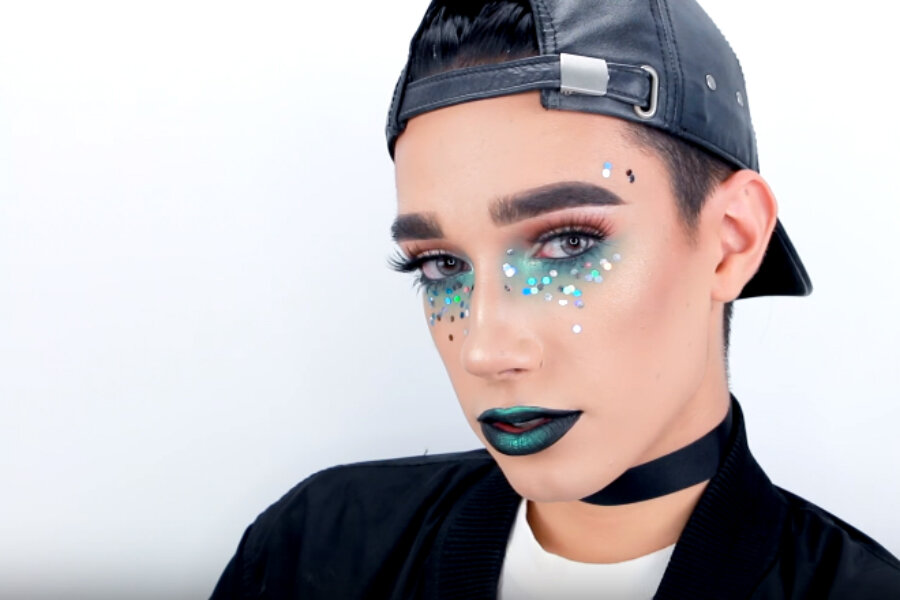On men and makeup: CoverGirl announces first ‘CoverBoy’
Loading...
You read that correctly: The newest CoverGirl is a boy.
James Charles, a 17-year-old makeup artist from New York, will be the new face of the iconic cosmetics brand. James, who first earned fame through makeup tutorial videos and popular social media accounts, will be the first male ‘spokesmodel’ in CoverGirl’s 55-year history.
Given the teen’s talent with brush and pen, it’s an obvious pairing. But the partnership may also signal changing tides – both in the gendered world of makeup and in American culture at large.
CoverGirl isn’t the first cosmetic brand to eschew “hegemonic notions of femininity,” says Cornell University anthropologist Oneka LaBennett in a phone interview with The Christian Science Monitor. Since its founding in 1985, Toronto-based MAC Cosmetics has worked with such LGBQT celebrities as RuPaul and KD Lang.
Nor is it the brand’s first attempt at breaking down barriers. In an industry that has been criticized for not accommodating women of color, the faces of CoverGirl have been diverse: Queen Latifah, Rihanna, Janelle Monáe, Dania Ramirez, and Zendaya have all been featured.
But never has it featured a man. So why now?
For one thing, James has a considerable social media presence in a world that increasingly values social media. This type of public figure has the visibility of a traditional celebrity but at the same time already interacts with fans and followers on a personal level. And that influence is powerful.
“We’re seeing a lot of interesting things with these social media stars, from a marketing standpoint,” says Robyn Goodman, a professor of advertising at the University of Florida, in a phone interview with the Monitor. “Companies are partnering with them to parlay their fame online so that the companies themselves may feel more authentic to Millennial and Gen Z audiences.”
Companies can also win over younger audiences by making social statements. CoverGirl already has spokesmodels of different races and ages, so perhaps gender is simply the next frontier.
“I think they’re kind of making the statement that they’re for everybody,” Dr. Goodman says. “So it’s not surprising that it’s male cosmetics at this point.”
But the relationship goes both ways. As brands like CoverGirl discover the influence of social media, young people have more power than ever to “dictate what gets sold to them and how it gets marketed to them,” Dr. LaBennett says.
“For someone who studies youth culture, James Charles as the face of Covergirl demonstrates that youth have a great deal of agency in terms of influencing consumer culture. I think that’s a part of the story here, too.”
And with that newfound influence, that generation’s values are becoming increasingly visible. James’s selection may be a reflection of that change.
“We’re at the cusp of potentially electing the first woman president of the United States, so we know that there’s a shift going on in terms of gender norms,” LaBennett says. “We know that there’s been an increased awareness of queer and trans people in our popular consciousness. It makes sense that in all aspects of American life, including the consumer realm, including cosmetics, we would see those shifts.”
It’s unsurprising, then, that James himself appears to embody those shifts.
“Breaking gender norms just comes instantly as soon as a boy is comfortable and confident enough to put on makeup. I think it’s so important to love who you are and be comfortable in your own skin,” James told BuzzFeed.
In August, media outlets clamored over Jaden Smith’s new, gender-neutral fashion line “MSFTSrep.” But the young celebrity didn’t seem to understand the fuss.
“We talked about it, but he was like ‘What’s the big deal?’ It’s going to filter up through the generations, but I think that’s really one of the hallmarks of the younger generation, this idea of fluidity,” Goodman says.
It’s likely, LaBennett says, that Charles will be welcomed just as casually by his generational peers. But will more men follow his lead?
“People of this age group are going to see James Charles as a perfectly legitimate CoverGirl, and I think that CoverGirl is smart to appeal to young people in this way,” LaBennett says. “But I think CoverGirl also hopes that this means more men will wear and buy makeup. That just means more revenue for them.”








